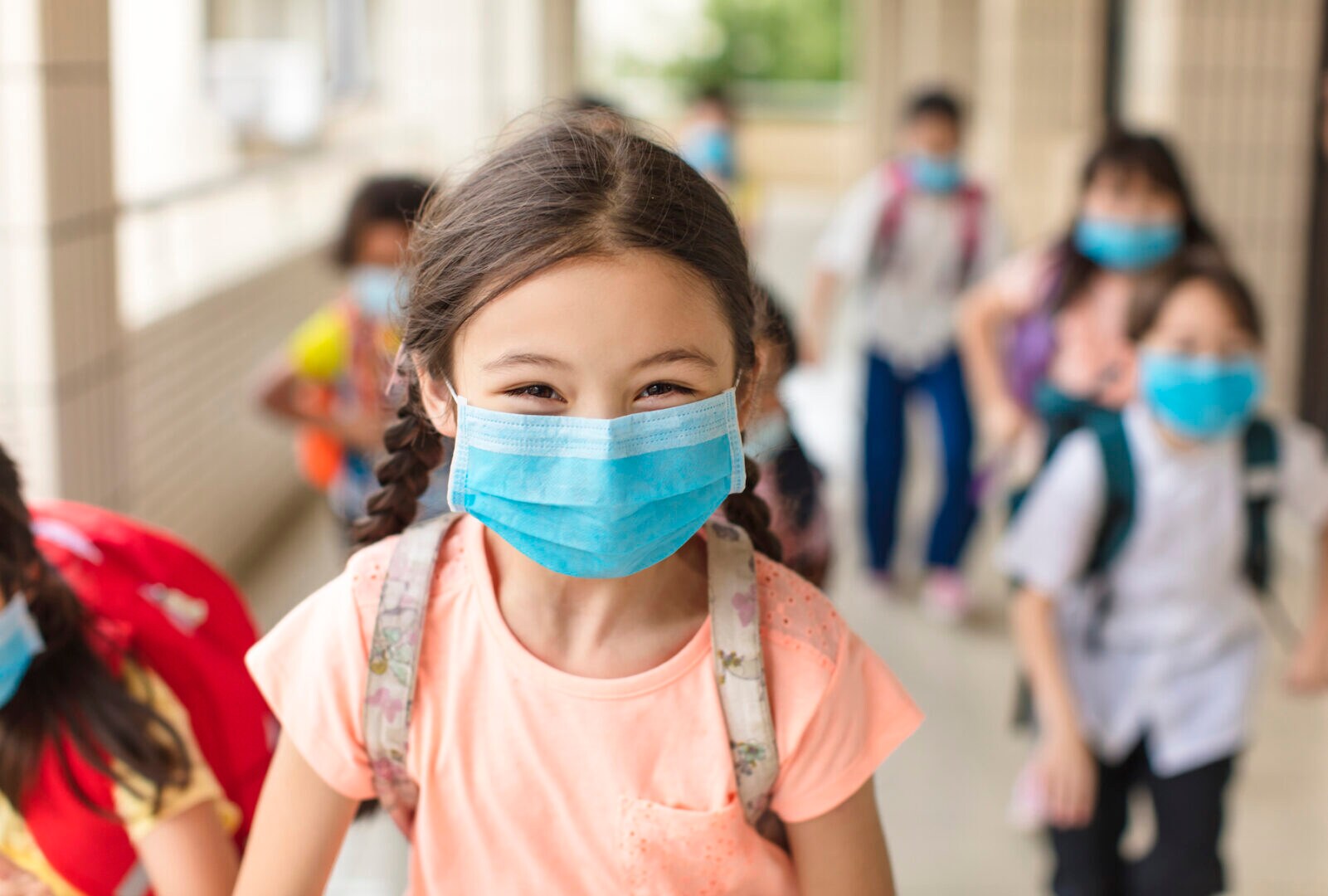What started out as a joyous summer for many Americans is quickly devolving into what feels like a panicky fall — particularly for parents with school-aged kids. A few months after proclamations of potentially maskless, full-time, in-person school were made by officials (based on vaccination availability and declining COVID numbers), a new variant has entered the chat: delta.
As experts learn more about the delta variant, it’s been deemed more contagious than previous mutations. In turn, experts, including the Centers for Disease Control and Prevention (CDC), are revising previous school recommendations, giving the back-to-school season a low-grade anxiety it didn’t have a few weeks back.
While parents don’t need to go into full-on panic mode due to delta, Dr. Mary Rodgers, principal scientist and head of infectious disease research at Abbott, notes that now certainly isn’t the time to slack on tried-and-true safety precautions either.
“As schools are returning to in-person learning, we want to watch out for kids and take the proper precautions we can to keep them safe and healthy,” Rodgers explains, adding that this holds true, regardless of the variant. “Also, by mitigating spread now, we can potentially avoid other variants from popping up down the line.”
“We want to watch out for kids and take the proper precautions we can to keep them safe and healthy. Also, by mitigating spread now, we can potentially avoid other variants from popping up down the line.”
— DR. MARY RODGERS, PRINCIPAL SCIENTIST
Wondering how to keep kids safe and healthy amid delta and how the new variant may affect children and the school year ahead? Experts weigh in.
Is the delta variant more dangerous to children?
It’s too soon to tell, say experts at this time, but there is currently a lot more potential for spread and illness among children for a couple of reasons. According to Dr. Larry Kociolek, attending physician in the division of infectious diseases and medical director of infection prevention and control at Lurie Children’s Hospital in Chicago, the odds of children catching the delta variant of COVID are higher due to its infectiousness, and risks become particularly higher in the absence of recommended safety precautions.
“With more transmissible variants circulating, children may be more likely to catch COVID-19 from families and friends with COVID-19, especially when prevention measures, such as masking, are not used,” Kociolek says. “We have already seen increases in cases among children across the U.S., partly because vaccines are not yet available to all children.
“With more transmissible variants circulating, children may be more likely to catch COVID-19 from families and friends with COVID-19, especially when prevention measures, such as masking, are not used.”
— DR. LARRY KOCIOLEK,
MEDICAL DIRECTOR OF INFECTION PREVENTION & CONTROL
Experts are not seeing evidence that the delta variant is causing more severe illness in kids, says Kociolek, and hospitalization and death remain “very rare” complications in children. “But with rising numbers of infections,” he explains, “we will likely see more children being hospitalized, and possibly dying, simply related to increases in numbers of COVID-19 cases.”
In other words, as The New York Times put it recently: It’s a “numbers game.” As cases of the more contagious delta variant surge in unvaccinated adults (breakthrough cases make up a very small number), more kids who can’t yet be vaccinated are going to catch it. And that means the odds of infected children who do get severely ill, even though rare, still go up.
“We have already seen increases in cases among children across the U.S., partly because vaccines are not yet available to all children.”
— DR. LARRY KOCIOLEK
The American Academy of Pediatrics (AAP) reported that while there’s still an “urgent need to collect data on the longer-term impacts of the pandemic on children,” the percentage of children who fall seriously ill is very low. According to data published by the AAP on August 8 (in states that report their numbers), 0.1%-1.9% of all child COVID-19 cases resulted in hospitalization and 0.00%-0.03% of all child COVID-19 cases resulted in death.
Is it safe to go back to school with the delta variant?
On August 5, the CDC updated their guidelines for COVID prevention in schools K-12 (more on this shortly), but the organization maintains that having kids return to school full time and in person is a top priority, as research has shown that kids learn significantly more when in the classroom and their mental health is better, too.
And while any uptick in kids getting COVID is concerning, experts remain steadfast on school being safe for children at this point, so long as safety precautions are in place. “We are still gathering data on delta,” says Dr. Stephanie DeLeon, a pediatrician at Oklahoma Children’s Hospital in Oklahoma City, “but proper precautions should make schools safer for everyone.”
“We are still gathering data on delta, but proper precautions should make schools safer for everyone.”
— DR. STEPHANIE DELEON, PEDIATRICIAN
According to both DeLeon and Kociolek, the following layered risk mitigation measures made schools safe for students and staff last year and should do the same this year even with the delta variant circulating:
- Masking.
- Physical distancing.
- Improved ventilation.
- Frequent hand hygiene.
- Exclusion of sick kids.
- Contact tracing and quarantining following exposures.
- Screening tests for COVID in some places.
In addition, DeLeon urges:
- Limiting class size.
- Cohorting classmates into small groups, especially during lunch times.
Kociolek adds, “Improving vaccination rates among students eligible, as well as teachers, will make schools safer.”
“Improving vaccination rates among students eligible, as well as teachers, will make schools safer.”
— DR. LARRY KOCIOLEK
The White House recently released a statement, saying that almost 90% of teachers and staff are vaccinated, but for some educators, the new variant is nerve-wracking, even with precautions in place. While nothing is 100% fail-proof, experts assure that layered safety approaches (especially when coupled with the vaccine) make schools pretty darn safe.
How will the delta variant affect the 2021-22 school year?
While the majority of schools are still on track to open up full time, the delta variant has caused experts — including the CDC — to pump the brakes on what was set to be a return to normalcy.
Here are updates to the CDC’s guidelines for school openings due to the delta variant:
- Indoor masking for everyone, regardless of vaccination status (previously it was recommended for anyone who wasn’t vaccinated).
- Testing fully vaccinated people who have been exposed to someone with suspected or confirmed COVID three to five days after exposure, regardless of whether they have symptoms.
While the CDC’s recommendations are guidelines, not mandates, and will continue to evolve, it’s important for schools to follow them, Rodgers explains, adding that precautions such as proper sanitizing and maintaining social distance (both of which the CDC recommends) will help mitigate risk for families.
Are playdates and indoor extracurriculars safe?
“It’s inevitable that activities, playdates and sports return with the onset of school,” Rodgers acknowledges. “That being said, with the new variant, it’s important to continue to be COVID cautious and explore ways to keep playdates or gatherings on the smaller side and outside as much as possible.”
“It’s important to continue to be COVID cautious and explore ways to keep playdates or gatherings on the smaller side and outside as much as possible.”
— DR. MARY RODGERS
Kociolek adds that, in communities with elevated COVID-19 transmission rates, parents should be extra vigilant with extracurriculars. “In areas with high case numbers, there’s risk of getting COVID when having close contact with unvaccinated people, particularly when indoors,” he says. “Masks and distancing can help make these activities safer if you can’t go outside.”
What can parents do to up safety precautions once school starts?
A post-COVID world was starting to seem within reach a few weeks ago, but delta has put a damper on that. As of now, parents and kids can expect a school year that’s more normal than last, but we’re still not in the carefree maskless, personal space-invading days of early 2019. And until we’re there, it’s important parents with unvaccinated kids try to implement mitigation tactics (even though, yes, it’s exhausting).
“Parents should continue to have their children mask up when in indoor environments, particularly in areas with elevated community COVID-19 transmission rates,” Kociolek says. “They should also consider avoiding large gatherings, particularly those that are indoors and with unvaccinated individuals.”
“Parents should continue to have their children mask up when in indoor environments, particularly in areas with elevated community COVID-19 transmission rates.”
— DR. LARRY KOCIOLEK
Additionally, Rodgers recommends picking up a rapid home COVID test to keep on hand. “With the back-to-school season, frequent rapid testing for COVID-19, which tests for delta, can help catch infections and mitigate the spread,” Rodgers says. “Students and staff can use a test like BinaxNOW COVID self-test to get a result in 15 minutes, allowing people to either take necessary steps to quarantine or remain in school. They can be picked up at the drugstore.”

Where to buy:
BinaxNOW COVID-19 Antigen Self Test ($24, CVS)
DeLeon also notes that everyone needs to determine their “risk tolerance,” as every activity/interaction carries some risk. “Folks should be aware of local transmission rates as well, because the risk may be higher or lower in different parts of the country,” she says.
How will this school year compare to 2020?
In short, things could be better or worse, depending on where you live.
“Thankfully, vaccination remains highly effective, even against the delta variant,” Kociolek says. “So it’s unlikely that areas with high vaccination rates will experience surges of COVID-19 similar to what was seen previously. But the areas with very low vaccination rates may see surges that mirror what was seen in the fall and winter of 2020.”
And as Rodgers points out, there’s more information available in regards to COVID, and testing is more widely available and accurate.
“It’s unlikely that areas with high vaccination rates will experience surges of COVID-19 similar to what was seen previously.”
— DR. LARRY KOCIOLEK
As for whether or not we’ll see a COVID surge in the fall/winter flu season — that also depends on the transmission/vaccination rate in a given area, along with public health precautions. Research from Johns Hopkins predicts that for areas with high vaccination rates and “control measures” in place, such as masking indoors, the fall may not look so bleak. On the flip side, though, the opposite is true for communities with low vaccination rates and weak control measures.
All of this said, so long as the virus keeps mutating, it’s nearly impossible to predict what COVID has in store in the weeks ahead. “Many of our epidemiologists and infectious disease specialists are worried about the next few months,” DeLeon says. “But fortunately, we have better tools at the ready than we did in 2020.”






